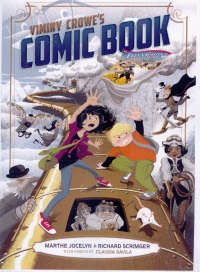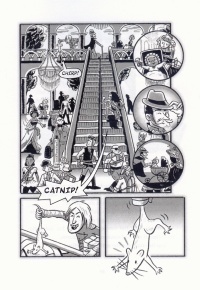| ________________
CM . . .
. Volume XX Number 29. . . .March 28, 2014
excerpt:
Twelve-year-old Wylder and Addy, both attending ComicFest in Toronto, stumble separately into a portal that transports them into the steampunk world of a comic created by Addy’s uncle, Viminy Crowe. Finding themselves trapped, they are forced into dangerous situations, realizing that they are changing the plot of the comic by their very presence. Wylder eventually figures out how to escape—by turning to the back page ad for ComicFest—but accidentally takes not Addy with him, but her look-alike Nelly, a character Crowe modelled after her. Back in Toronto, Crowe and Wylder figure out that it is actually the things that Addy and Wylder have left behind—such as Wylder’s backpack which causes hero Flynn Goster to trip into an alligator tank, losing an arm in the process—that are messing up the story. Fearing for Addy, and for Crowe’s book’s success, Wylder convinces Nelly to return through the portal to rescue Addy and retrieve their personal effects. Things go horribly wrong when Crowe, himself, crosses the portal, causing every character he has ever sketched to come to life, and leaving them temporarily stranded in a post-apocalyptic Toronto with a burned copy of the comic, missing the ComicFest ad. Addy saves the day by simply drawing a picture of her apartment door, leaving all three rescued and Crowe’s comic back to normal.
And it is the comic that is both the best and the most frustrating feature here. The best, because Crowe’s character inventions—the suave yet geeky Flynn Goster, the daring and dazzling Isabella Fortuna, the evil Professor Lickpenny and his robot “mechanizmos”, not to mention the brilliant robot ServiDudes who tend to every need on the train—are fascinating. Although the action is occasionally difficult to discern in the heavy-lined black-and-white comic panels, and never reflected in the actual text, the characters are brilliantly drawn, exaggerated caricatures. But the fact that the actual comic is not contained in the book makes it less than satisfying—how can readers know what is going wrong when they don’t know they actual original story? Addy and Wylder are constantly saying that they are in the part where such-and-such happens, or that this is not what is supposed to be happening here—but even by the end of the book, the picture that emerges of the original plot is fuzzy at best. When the story does really get moving, though, it is highly exciting and full of cliffhangers and sudden discoveries—like when Wylder discovers his half-eaten box of onion rings, among his abandoned personal effects, is responsible for the mechanizmos’ malfunction and destruction of the train. And although relationship takes a back seat to action and intrigue, the initial frostiness between Addy and Wylder is well portrayed, as is their eventual grudging friendship, and the occasional mentions of regret about coming from single-parent households. In the end, readers will be thrilled, but wish they’d actually been able to read about Flynn Goster in the first place. Recommended with Reservations. Todd Kyle is the CEO of the Newmarket Public Library in Ontario.
To comment
on this title or this review, send mail to cm@umanitoba.ca.
Copyright © the Manitoba Library Association. Reproduction for personal
use is permitted only if this copyright notice is maintained. Any
other reproduction is prohibited without permission.
NEXT REVIEW |
TABLE OF CONTENTS FOR THIS ISSUE
- March 28, 2014.
AUTHORS |
TITLES |
MEDIA REVIEWS |
PROFILES |
BACK ISSUES |
SEARCH |
CMARCHIVE |
HOME |

 A very intricate story, this book is made up mostly of straight narrative, alternating between Wylder’s and Addy’s viewpoint, interspersed with occasional comic panels illustrating action scenes. The concept here is that not only do the pair stumble into a parallel fictional world, but that their presence changes the content of Addy’s copy of the comic as they go along; that, at the end of every two-page spread, they find themselves literally bumping into the end of the panel; that they have to quickly turn the page (or turn to another page) to go elsewhere in the story. But the Gordian knot of this logic is at times confusing and even contradictory. Addy and Wylder seem strangely unaware of the cause-and-effect happening around them until it is too late. When they land on a beach from a chewing-gum ad in the comic, they wait several minutes before checking what page they are on. In the same scene, the opposite page contains comic action that they are not part of, yet they might be expected to be, as they’ve previously participated in all the action on each double-page spread. The trio are frantic to retrieve the items they’ve left behind, having learned that they inevitably change the story, and yet are unfazed by the realization at the end that Addy also left her shoes in the comic.
A very intricate story, this book is made up mostly of straight narrative, alternating between Wylder’s and Addy’s viewpoint, interspersed with occasional comic panels illustrating action scenes. The concept here is that not only do the pair stumble into a parallel fictional world, but that their presence changes the content of Addy’s copy of the comic as they go along; that, at the end of every two-page spread, they find themselves literally bumping into the end of the panel; that they have to quickly turn the page (or turn to another page) to go elsewhere in the story. But the Gordian knot of this logic is at times confusing and even contradictory. Addy and Wylder seem strangely unaware of the cause-and-effect happening around them until it is too late. When they land on a beach from a chewing-gum ad in the comic, they wait several minutes before checking what page they are on. In the same scene, the opposite page contains comic action that they are not part of, yet they might be expected to be, as they’ve previously participated in all the action on each double-page spread. The trio are frantic to retrieve the items they’ve left behind, having learned that they inevitably change the story, and yet are unfazed by the realization at the end that Addy also left her shoes in the comic.